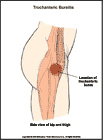
Trochanteric Bursitis
What is trochanteric bursitis?
Trochanteric bursitis is irritation or inflammation of the trochanteric bursa. A bursa is a fluid-filled sac that acts as a cushion between tendons, bones, and skin. The trochanteric bursa is located on the upper, outer area of the thigh. There is a bump on the outer side of the upper part of the thigh bone (femur) called the greater trochanter. The trochanteric bursa is located over the greater trochanter.
How does it occur?
The trochanteric bursa may be inflamed by a group of muscles or tendons rubbing over the bursa and causing friction against the thigh bone. This injury can occur with running, walking, or bicycling, especially when the bicycle seat is too high.
What are the symptoms?
You have pain on the upper outer area of your thigh or in your hip. The pain is worse when you walk, bicycle, or go up or down stairs. You have pain when you move your thigh bone and feel tenderness in the area over the greater trochanter.
How is it diagnosed?
Your health care provider will ask about your symptoms and examine your hip and thigh.
How is it treated?
Treatment may include the following:
- putting ice packs on your thigh for 20 to 30 minutes every 3 to 4 hours for 2 to 3 days or until the pain goes away
- taking anti-inflammatory medication prescribed by your health care provider
- getting a corticosteroid injection into the bursa to reduce the pain and swelling.
While you are recovering from your injury you will need to change your sport or activity to one that does not make your condition worse. For example, you may need to swim instead of running or bicycling. If you are bicycling, you may need to lower your bicycle seat.
When can I return to my sport or activity?
The goal of rehabilitation is to return you to your sport or activity as soon as is safely possible. If you return too soon you may worsen your injury, which could lead to permanent damage. Everyone recovers from injury at a different rate. Return to your sport or activity will be determined by how soon your leg recovers, not by how many days or weeks it has been since your injury occurred. In general, the longer you have symptoms before you start treatment, the longer it will take to get better.
You may safely return to your sport or activity when, starting from the top of the list and progressing to the end, each of the following is true:
- You have full range of motion in the injured leg compared to the uninjured leg.
- You have full strength of the injured leg compared to the uninjured leg.
- You can jog straight ahead without pain or limping.
- You can sprint straight ahead without pain or limping.
- You can do 45-degree cuts, first at half-speed, then at full-speed.
- You can do 20-yard figures-of-eight, first at half-speed, then at full-speed.
- You can do 90-degree cuts, first at half-speed, then at full-speed.
- You can do 10-yard figures-of-eight, first at half-speed, then at full-speed.
- You can jump on both legs without pain and you can jump on the injured leg without pain.
How can I prevent trochanteric bursitis?
Trochanteric bursitis is best prevented by warming up properly and stretching the muscles on the outer side of your upper thigh.

